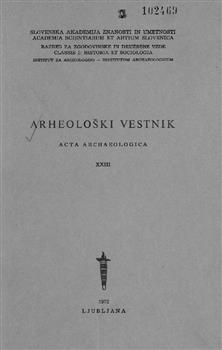Staroslovansko grobišče v Zgornjem Dupleku, antropološko poročilo
Povzetek
From the cemeitery at Zgornji Duplek we received for anthropological examination eight skeletons. Skeletons No. 2. to 4. were dug through and were in paper bags, skeletons No. 5. to 9. were exeminated in situ. All skeletons were cleaned, glued and partially reconstructed in the laboratory of Anthropological department of Biotehnical faculty in Ljubljana. At our work we used standard instruments and methods for measuring, age and sex determination and estimation of stature. The following skeletons were determined: skeleton No. 2 — female, adultus (25—30 years) skeleton No. 3 — male, maturus (40—50 years) skeleton No. 4 — female, adultus skeleton No. 5 — female, adultus (30—40 years) skeleton No. 6 — child, infans II (7—8 years) skeleton No. 7 — child, infans I (6—7 years) skeleton No. 8 — child, infans I (4—5 years) skeleton No. 9 — child, infans II (7—8 years) All measurements in cranium and postcranium are shown in tables No. 1 and No. 2. Of all eight skeletons four were children (No. 6 to 9) one was male (No. 3) and three were female (No. 2, 4 and 5). According to the results we can see that among female skeletons there is a large homogenity in some measures in cranium and postcranium. Both female (No. 2 and 5) and also the male cranium are of medium length (mesocranic) and hight with regard to breadth and lenght of cranium. All the three are ovoid with bomb forming occipital part. Postcranial part of female skeletons was gracile and of male medium strong with higer value of pilastric and platymeric index. Most of other mesaures and indices have higher value in male skeleton. We didn’t find any special pathological changes or anomalies except a small exostosis in left tibia in male skeleton. Teeth condition is medium except the case of paredentosis in skeleton No. 2, strong abrasion conected with athrophy in maxille and mandible in skeleton No. 5 and some cases of caries. Because of bad preserved skeletons we could not describe all epigenetical traits which a in some cases important in studies of connections between populations and within a pot)lc lation. In spite of a small number of such traits there is a possibility that some person in jv' small cemetery were in relation. Indication to such connection are non matrical traits 'S female skull No. 5 and child skull No. 9 and in child skull No. 6 and No. 7. ln The most corresponding skeletal material for comparison is the material from the sit Turnišče near Ptuj which is in the same region of Slovenia. When looking over the result which can be compared we established some analogy between the material from Turnišče and our small series from Zgornji Duplek. At Turnišče in most cases skulls are also meso cranic and acrocranic (Hypsicranic). These traits distinguish Turnišče from all other Slo vene cemeteries from the same period (for ex. Bled and Ptuj). Body stature corresponds onlv in male and female skeleton No. 5. Average bodystature in Turnišče for female was 153.0 cm and for male 168.0 cm. Other female skeletons (No. 2 and No. 4) have a higher body stature of 159 cm. Our series of four child and four adult skeletons is too small for extensive conclusions but all the same shows very interesting inner homogenity as well as analogy with skeletal material from Turnišče.
Prenosi
Prenosi
Objavljeno
Kako citirati
Številka
Rubrike
Licenca

To delo je licencirano pod Creative Commons Priznanje avtorstva-Nekomercialno-Deljenje pod enakimi pogoji 4.0 mednarodno licenco.
Avtorji jamčijo, da je delo njihova avtorska stvaritev, da v njem niso kršene avtorske pravice tretjih oseb ali kake druge pravice. V primeru zahtevkov tretjih oseb se avtorji zavezujejo, da bodo varovali interese založnika ter da bodo povrnili morebitno škodo.
Podrobneje v rubriki: Prispevki





